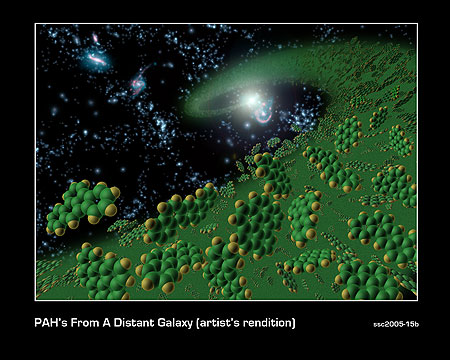Complex carbon-based molecules are considered the building blocks of life. Now the Spitzer Space Telescope has detected evidence for molecules made up of hydrogen and carbon in galaxies some 10 billion light years from Earth. The organic compounds — polycyclic aromatic hydrocarbons, known as ‘PAHs’ — are common on Earth and in galaxies like the Milky Way, but no instrument has found them as far back in time as Spitzer.
PAHs are called ‘organic’ because of their carbon atoms. That doesn’t translate to ‘life-bearing,’ for any molecule containing carbon is considered ‘organic,’ whether or not biology is involved. But find organic compounds and you find at least the potential for life.

“This is 10 billion years further back in time than we’ve seen them before,” said Dr. Lin Yan of the Spitzer Science Center at the California Institute of Technology in Pasadena, Calif. Yan and team will publish their findings in the August 10 issue of the Astrophysical Journal. What makes the Spitzer work unique is that the space-borne telescope is 100 times more sensitive than previous infrared telescope missions, making such long-distance detections possible, and proving that organic materials like this existed well before our own Solar System formed.
Image: This artist’s conception symbolically represents complex organic molecules, known as polycyclic aromatic hydrocarbons, seen in the early universe. These large molecules, comprised of carbon and hydrogen, are considered among the building blocks of life. Credit: NASA/JPL-Caltech/T. Pyle (SSC/Caltech).
Centauri Dreams‘ take: Pushing back the origin of complex compounds like these tells us that life may have had the opportunity to emerge quite early in the history of the universe. That brings the Kardashev classification of civilizations to mind. Recall Kardashev’s Type 1, a civilization that can control all the resources of its home world. A Type 2 controls the energy output of its Sun, while a Type 3 can control the power of an entire galaxy.
Can a Type 3 civilization have evolved in the observable universe? We know little about the life expectancies of civilizations (like many of the other elements of the Drake Equation, this one remains frustratingly unknown), but finding organic molecules at a time when the universe was only a quarter of its current age lends credence to the idea that even billions of years ago, cultures could have formed and lived long enough to create galaxy-spanning civilizations. Will our expanding SETI searches one day find evidence of their existence?
The paper is Yan, L., Chary, R., Armus, L. et al., “Spitzer Detection of PAH and Silicate Dust Features in the Mid-Infrared Spectra of z~2 Ultraluminous Infrared Galaxies,” available online at the arXiv site. Be aware, too, of Robert Hurt’s article “Understanding Polycyclic Aromatic Hydrocarbons,” a solid overview of this useful indicator of organic chemistry and possible life. The Spitzer news release is here.

